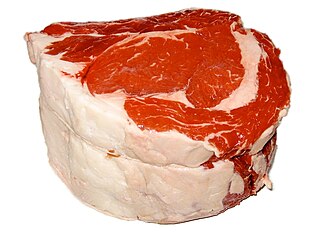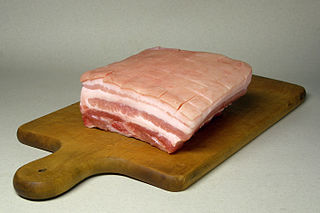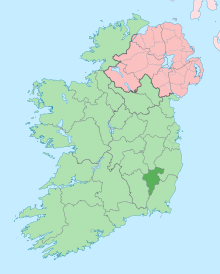
Beef is the culinary name for meat from cattle. Beef can be prepared in various ways; cuts are often used for steak, which can be cooked to varying degrees of doneness, while trimmings are often ground or minced, as found in most hamburgers. Beef contains protein, iron, and vitamin B12. Along with other kinds of red meat, high consumption is associated with an increased risk of colorectal cancer and coronary heart disease, especially when processed. Beef has a high environmental impact, being a primary driver of deforestation with the highest greenhouse gas emissions of any agricultural product.

Polychlorinated biphenyls (PCBs) are highly carcinogenic chemical compounds, formerly used in industrial and consumer products, whose production was banned in the United States by the Toxic Substances Control Act in 1976 and internationally by the Stockholm Convention on Persistent Organic Pollutants in 2001.
Polychlorinated dibenzodioxins (PCDDs), or simply dioxins, are a group of long-lived polyhalogenated organic compounds that are primarily anthropogenic, and contribute toxic, persistent organic pollution in the environment.

Advanced meat recovery (AMR) is a slaughterhouse deboning process by which the last traces of skeletal muscle meat are removed from animal bones after the primal cuts have been carved off manually. The machinery used in this process separates meat from bone by scraping, shaving, or pressing the meat from the bone without breaking or grinding the bone. AMR meat typically is used as an ingredient in products requiring further processing, such as hot dogs. Unlike mechanically separated meat, AMR meat is comparable in appearance, texture, and composition to meat trimmings and similar meat products derived by hand.

A product recall is a request from a manufacturer to return a product after the discovery of safety issues or product defects that might endanger the consumer or put the maker/seller at risk of legal action.

There are different systems of feeding cattle in animal husbandry. For pastured animals, grass is usually the forage that composes the majority of their diet. In turn, this grass-fed approach is known for producing meat with distinct flavor profiles. Cattle reared in feedlots are fed hay supplemented with grain, soy and other ingredients to increase the energy density of the feed. The debate is whether cattle should be raised on fodder primarily composed of grass or a concentrate. The issue is complicated by the political interests and confusion between labels such as "free range", "organic", or "natural". Cattle raised on a primarily foraged diet are termed grass-fed or pasture-raised; for example meat or milk may be called grass-fed beef or pasture-raised dairy. The term "pasture-raised" can lead to confusion with the term "free range", which does not describe exactly what the animals eat.

Clenbuterol is a sympathomimetic amine used by sufferers of breathing disorders as a decongestant and bronchodilator. People with chronic breathing disorders such as asthma use this as a bronchodilator to make breathing easier. It is most commonly available as the hydrochloride salt, clenbuterol hydrochloride.
This timeline of the 2007 pet food recalls documents how events related to the 2007 pet food recalls unfolded. Several contaminated Chinese vegetable proteins were used by pet food makers in North America, Europe and South Africa, leading to kidney failure in animals fed the contaminated food. Both the centralization of the pet food industry and the speed and manner of the industry and government response became the subjects of critical discussion.
In China, the adulteration and contamination of several food and feed ingredients with inexpensive melamine and other compounds, such as cyanuric acid, ammeline and ammelide, are common practice. These adulterants can be used to inflate the apparent protein content of products, so that inexpensive ingredients can pass for more expensive, concentrated proteins. Melamine by itself has not been thought to be very toxic to animals or humans except possibly in very high concentrations, but the combination of melamine and cyanuric acid has been implicated in kidney failure. Reports that cyanuric acid may be an independently and potentially widely used adulterant in China have heightened concerns for both animal and human health.

Intensive animal farming, industrial livestock production, and macro-farms, also known as factory farming, is a type of intensive agriculture, specifically an approach to animal husbandry designed to maximize production while minimizing costs. To achieve this, agribusinesses keep livestock such as cattle, poultry, and fish at high stocking densities, at large scale, and using modern machinery, biotechnology, and global trade. The main products of this industry are meat, milk and eggs for human consumption. There are issues regarding whether intensive animal farming is sustainable in the social long-run given its costs in resources. Analysts also raise issues about its ethics.

Yushō disease was a mass poisoning by polychlorinated biphenyls (PCBs) which occurred in northern Kyūshū, Japan, in 1968. In January 1968, rice bran oil produced by Kanemi Company in Kyushu was contaminated with PCBs and polychlorinated dibenzofurans (PCDFs) during production. For deodorization, the oil was heated using PCB as the heating medium, circulating through pipes. Due to holes in the pipes the PCB leaked into the rice bran oil. The contaminated rice bran oil was then sold to poultry farmers for use as a feed supplement and to consumers for use in cooking. In February to March 1968, farmers started reporting that their poultry were dying due to apparent difficulty in breathing; altogether 400,000 birds died. About 14,000 people who had consumed the contaminated rice oil were affected in Japan. More than 500 died. Common symptoms included dermal and ocular lesions, and a lowered immune response. Other symptoms included fatigue, headache, cough, and unusual skin sores. Additionally, in children, there were reports of poor cognitive development.

Ractopamine is an animal feed additive used to promote leanness and increase food conversion efficiency in farmed animals in several countries, but banned in others. Pharmacologically, it is a phenol-based TAAR1 agonist and β adrenoreceptor agonist that stimulates β1 and β2 adrenergic receptors. It is most commonly administered to animals for meat production as ractopamine hydrochloride. It is the active ingredient in products marketed in the US as Paylean for swine, Optaflexx for cattle, and Topmax for turkeys. It was developed by Elanco Animal Health, a division of Eli Lilly and Company.
The Dioxin affair was a political crisis that struck in Belgium during the spring of 1999. Contamination of feedstock with polychlorinated biphenyls (PCB) was detected in animal food products, mainly eggs and chickens. Although health inspectors reported the problem in January, measurements were taken only from May 1999 when the media revealed the case. The then Flemish Liberals and Democrats (VLD) opposition leader Guy Verhofstadt claimed that the government was trying to cover up the so-called "nota Destickere", which proved that several secretaries of state were informed much earlier that the food contained PCBs and dioxins.

Pork is the culinary name for the meat of the pig. It is the most commonly consumed meat worldwide, with evidence of pig husbandry dating back to 5000 BCE.

Dioxins and dioxin-like compounds (DLCs) are a group of chemical compounds that are persistent organic pollutants (POPs) in the environment. They are mostly by-products of burning or various industrial processes or, in the case of dioxin-like PCBs and PBBs, unwanted minor components of intentionally produced mixtures.
Pork in Ireland has been a key part of the Irish diet since prehistory. Ireland's flora and fauna overwhelmingly arrived via a Neolithic land bridge from Great Britain prior to its submerging around 12,000 BP. When the very first hunter-gatherers arrived around 2,000 years later, the local ecosystem largely resembled that of modern Ireland.

The 2013 horse meat scandal was a food industry scandal in parts of Europe in which foods advertised as containing beef were found to contain undeclared or improperly declared horse meat—as much as 100% of the meat content in some cases. A smaller number of products also contained other undeclared meats, such as pork. The issue came to light on 15 January 2013, when it was reported that horse DNA had been discovered in frozen beefburgers and lasagna sold in several Irish and British supermarkets.
The Chilean Pork crisis of 2008 was Chile's first ever mediatized dioxin crisis that led to major reputational and financial losses for the country due to a number of embargoes put up by importing countries like South-Korea. The main dioxin source has contaminated zinc oxide, which had been used as an animal feed ingredient for pigs. In reaction to the crisis the Chilean government has taken measures for the future to prevent such a crisis from happening again, by adopting regulation based upon European regulations for testing and concentration limits.
Christopher Elliott is a professor of food safety and microbiology at Queen's University Belfast and founder of the university's Institute for Global Food Security. He led the independent review of the UK food system after the 2013 horse meat scandal.


















